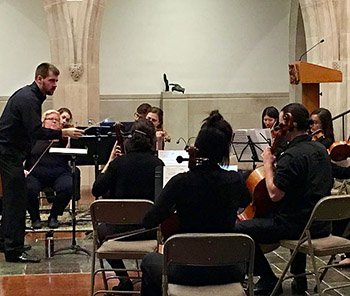by David Kulma

As shown by his Earth and Air programs, Ellis enjoys tying his musical choices to an overarching theme for the evening. Friday was no exception. Without intermission, the hour-long “Music of the Baltic Sea” framed works by Jean Sibelius (Finland), Carl Nielsen (Denmark), Johan Svendsen (Norway), and Carl Reinecke (Germany).
Representing Sibelius with two works, Ellis and company explored both of the composer’s main moods. The three movements of Rakastava, Op. 14 showed off his tendency toward building up the kind of busy, inconclusive textures familiar in his symphonies, while Andante Festivo is in his more melodic, patriotic vein — similar to Finlandia. The Andante, which opened the program, was the most successful. The Camerata gave it a pungent power and their best intonation of the night. “Wandering” Sibelius like Op. 14 is more difficult to pull off, but Ellis’s group gave the work a solid reading.
The first two movements of Reinecke’s six-movement Serenade in g, Op. 242 were sandwiched between the Sibelius pieces. Lovely examples of the conservative side of late 19th-century German Romanticism, the “Marcia” brought to mind something Elgar would do better in his Pomp and Circumstance Marches, while the “Arioso” was placidly beautiful if unmemorable. Ellis handled the music well, getting his group to shape its tonal lines.
Ellis ended the concert by leading directly from Svendsen’s Two Swedish Folk Melodies, Op. 27 into Nielsen’s Little Suite, Op. 1. Svendsen’s take on folk tunes is similar to his compatriot Grieg, while Nielsen’s three-movement string orchestra staple is a lovely chromatic enigma infused with dancing. Ellis chose the right tempos for each movement. The “Intermezzo” was just sprightly enough, while the coda to the “Finale” was full of gusto.
As might be expected, the level of musical comfort ranged across the orchestra. The excellent pros from Earth and Air — violinists Paula Castañeda and Irene Guerra, violist Cristian Diaz, cellist Aaron Fried, and bassist J. Tracy Mortimore — joined the students in a full investment in this enjoyable Baltic potpourri. Ellis should expand on this model with a full side-by-side. His students could learn a great deal from that experience.
Published on ClevelandClassical.com April 9, 2019.
Click here for a printable copy of this article



